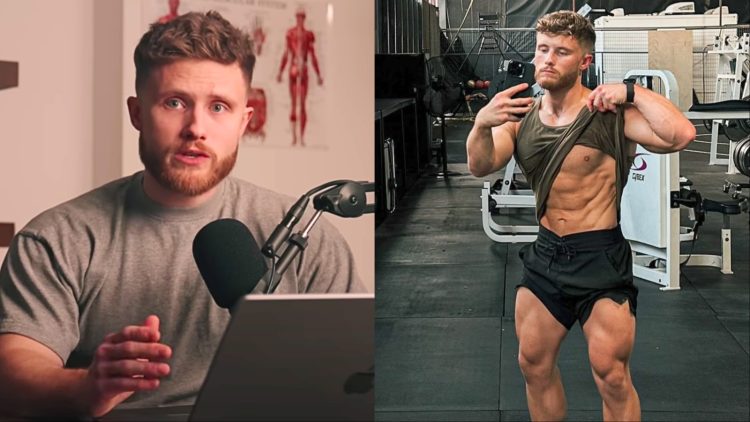Coach Jeff Nippard is back to break down an age-old fitness question: how hard should you train to build muscle? In his recent Jeff Nippard Fitness newsletter, Nippard gave his answer, revealing the science behind how to effectively add muscle tissue.
“When I started lifting, I noticed that pro bodybuilders routinely pushed themselves to their limits and beyond. I quickly (and naively) assumed this high level of effort must be the reason they were so much more jacked than me,” shares Nippard. “I simply needed to push harder.”
Boasting a jaw-dropping 4.58 million YouTube subscribers, Jeff Nippard’s science-based approach to fitness and bodybuilding has turned him into a worldwide star. He regularly offers technique breakdowns and gives his thoughts on all topics related to fitness, from building muscle, and nutrition, to his step-by-step instructions on how to perform the perfect deadlift, bench press, or squat.
Training intensity has always been a cornerstone of muscle-building, though given how often it varies, Nippard thought it was best to make a few clarifications. Below, he details how hard you must push yourself in the gym to achieve optimal muscle-building results.
Jeff Nippard Breaks Down How Hard You Should Train to Effectively Build Muscle
View this post on InstagramGet Fitter, FasterLevel Up Your Fitness: Join our 💪 strong community in Fitness Volt Newsletter. Get daily inspiration, expert-backed workouts, nutrition tips, the latest in strength sports, and the support you need to reach your goals. Subscribe for free!
With notable influencers like Sam Sulek routinely training to failure, Jeff Nippard provides some insight into how hard you should train.
“How Hard Should You Train to Build Muscle?
Little if anything has changed since then. I still regularly hear bodybuilders say things like “the muscle only knows failure,” suggesting you won’t make gains unless you push yourself to complete exhaustion.
Hell, even Sam Sulek (one of the most popular fitness influencers ever) trains to failure 96% of the time!
Are they right? Is that the best way to train? The science is a bit more nuanced.”
According to Nippard, researchers use reps in reserve (RIR) to measure how intensely someone is training. If you reach failure, you’re at a zero RIR, but only if you couldn’t perform another rep ‘if your life depended on it.’
“Researchers use a metric called reps in reserve, or RIR, to measure how hard someone is training.
If you hit failure, you’re at zero RIR. Zero RIR means you couldn’t have done another rep (with good form) if your life depended on it. One RIR means you could’ve done one more rep with your life on the line, but no more. Two RIR means you stopped with two reps in the tank. You get the idea.”
As for muscle-building goals, Nippard says you’re more likely to make those gains when you finish sets with zero to three RIR.
“You’re likely to make your best gains when you finish your sets with zero to three RIR.
If you finish most of your sets with more than three reps in the tank, you’re probably leaving some gains on the table. You’ll likely make more progress if you train a little harder.
But here’s where the nuance comes in. Your gains will be about the same if you train to failure or just get close to failure, without actually reaching zero RIR.”
Citing a new study, Nippard revealed that going to failure versus stopping with one or two RIRs saw similar muscle growth.
“In fact, a brand-new study (one of my favorites in recent years) showed basically the same muscle growth between going to failure and stopping with one or two RIR. And these were experienced lifters with at least three years of training!”
Below, you can find Nippard’s intensity recommendations for beginner and intermediate-to-advanced lifers:
- ‘Beginner (less than one year of lifting): Leave one to three reps in the tank for the majority of your sets. It’s much more important to focus on technique at this stage, especially on compound exercises like barbell deadlifts, presses, and squats. If you want to experience what it feels like to train to failure, do it with simple machine or cable exercises toward the end of your workout.
- Intermediate to advanced (more than one year of lifting): Take the majority of your working sets to one or two RIR. On low-risk exercises, take the final set to failure.’
He emphasizes that lifters who never go to failure will never know how it feels to keep one to three reps in reserve.
“If you never go to failure, you’ll never know what one to three RIR feels like. That’s why, unless I’m doing deadlifts or squats, I almost always take my last set of each exercise to failure.”
Ultimately, the credentialed coach underlines that if you leave the gym knowing you worked hard and made steady progress toward goals, you’re on the right track.
“Bottom line:
If you leave the gym knowing you worked hard, and you’re making steady progress toward your goals, keep going. You’re doing great.
But if you’re disappointed with your progress, and you rarely feel as if you pushed yourself, training a little harder might be exactly what you need.”
Aside from his latest pointers for growing muscle, Nippard doesn’t miss an opportunity to trade ideas with other masterminds of fitness. Recently, he joined exercise scientist/physiologist Dr. Mike Israetel for an intricate discussion about how to scientifically build the shoulders.
Always using evidence to support his assertions, Jeff Nippard’s advice remains highly sought after within the fitness and bodybuilding niche. Feel free to apply his tips about intensity in your next workout!









